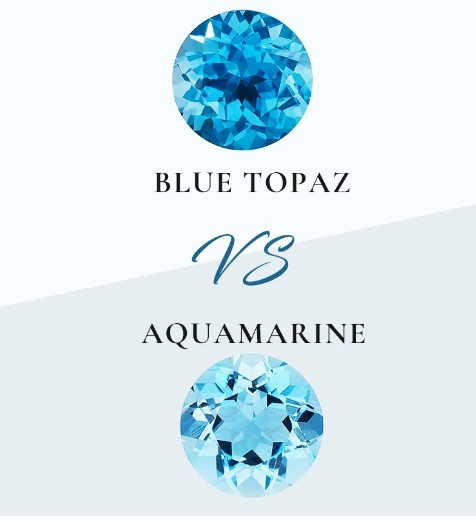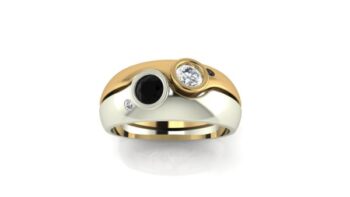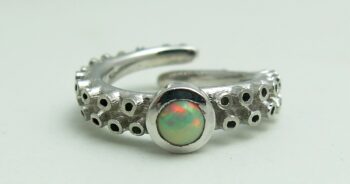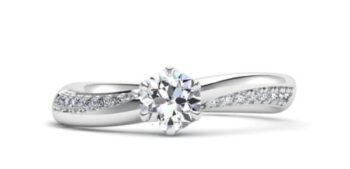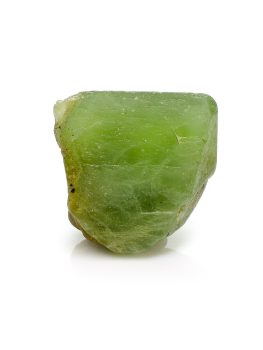Aquamarine And Topaz look very similar. In fact, we will admit to thinking many sky blue topaz were aquamarine just by looking at them. To correctly identify what we were looking at required a refractometer. Unfortunately, this can be problematic for many aquamarine buyers as there are dishonest sellers out there selling topaz as aquamarine. And If it happened to us, it can easily happen to those with an untrained eye. However, do not worry. there are ways to tell the difference between Aquamarine And Topaz that do not require a $350 piece of equipment. It is unfortunate that we need to teach people how to do this. But unfortunately, there is a need to make sure you are getting what you paid for these days.
What Is Topaz?
Topaz is a gemstone that comes in a variety of colors, including yellow, blue, pink, and clear. It is known for its stunning beauty and is often used in jewelry. The name “topaz” comes from the Sanskrit word “tapas,” meaning fire. This is fitting, as topaz is known for its fiery brilliance.
Topaz is a fascinating gemstone with unique physical properties. First and foremost, its color can vary greatly, ranging from colorless to yellow, pink, blue, and even brown. This diversity makes topaz a versatile and eye-catching gem. Additionally, topaz has a relatively high hardness, scoring an 8 on the Mohs scale. This makes it durable and suitable for everyday wear. Lastly, topaz has a distinct crystal structure, often appearing in prismatic or tabular forms. Its crystal habit adds to its allure and makes it a popular choice in jewelry.
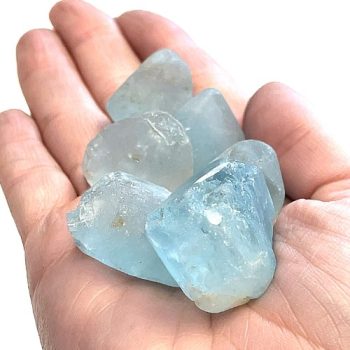
What Is Aquamarine?
Aquamarine is a gemstone that is known for its stunning blue-green color. It is a variety of the mineral beryl and gets its name from the Latin words “aqua” meaning water and “marina” meaning sea. This gemstone is typically found in Brazil, but can also be found in other countries such as Nigeria, Madagascar, and Afghanistan.
Aquamarine is type of beryl which ranges from 7.5 to 8 on the Mohs scale. This makes it a durable gemstone that can withstand everyday wear and tear.
Another notable physical property is its transparency, as aquamarine is typically transparent to translucent. This allows light to pass through the gemstone, giving it a radiant and sparkling appearance. Lastly, aquamarine has a specific gravity of around 2.68 to 2.74, which means it is denser than water. This property contributes to its overall weight and feel. In my opinion, aquamarine’s physical properties make it a stunning gemstone that is both visually appealing and durable for jewelry purposes. Whether you’re looking for a statement piece or a delicate accessory, aquamarine is a gemstone that is sure to catch the eye.
One of the most striking physical properties of aquamarine is its color. The blue-green hue is reminiscent of the clear waters of a tropical paradise. It is a color that is both calming and refreshing, making it a popular choice for jewelry. The color can range from a pale, almost transparent blue to a deep, vibrant green.
Another physical property of aquamarine is its hardness. On the Mohs scale, which measures a mineral’s resistance to scratching, aquamarine ranks at 7.5 to 8. This makes it a durable gemstone that can withstand everyday wear and tear. However, it is still important to take care of your aquamarine jewelry to ensure its longevity.
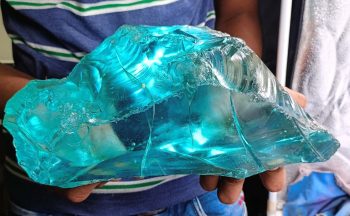
How Are Aquamarine And Blue Topaz Similar?
Aquamarine and blue topaz are both stunning gemstones that share some similarities. Firstly, they both belong to the beryl family, which includes other gems like emerald and morganite. This means that they have a similar chemical composition, with aquamarine being a variety of beryl that is colored by traces of iron, and blue topaz being a variety of topaz that is irradiated to achieve its vibrant blue hue.
Another similarity between aquamarine and blue topaz is their striking color. Aquamarine is known for its beautiful light blue to greenish-blue shades, reminiscent of the clear waters of the ocean. Blue topaz, on the other hand, comes in a range of blue tones, from pale sky blue to deep Swiss blue. Both gemstones have a captivating and refreshing color that can instantly uplift any jewelry piece they are set in.
In terms of popularity and availability, both stones are widely loved and sought after by gemstone enthusiasts. They are commonly used in various types of jewelry, including rings, earrings, and pendants. While aquamarine is often associated with a more classic and elegant look, blue topaz offers a more modern and vibrant appeal. Ultimately, the choice between these two gemstones comes down to personal preference and the desired style.
How Are Aquamarine And Topaz Different?
Aquamarine and blue topaz may both be beautiful blue gemstones, but they have distinct differences. Aquamarine is known for its pale blue color, reminiscent of the ocean’s tranquil waters. On the other hand, blue topaz is a vibrant and intense blue gemstone. While aquamarine has a calming and soothing energy, blue topaz exudes a more energetic and dynamic vibe. In terms of hardness, aquamarine is slightly softer than blue topaz. Overall, both gemstones have their own unique charm and appeal, so it ultimately comes down to personal preference.
How To Tell The Difference?
When it comes to distinguishing between aquamarine and blue topaz, there are a few key factors to consider. First, take a look at the color. Aquamarine typically has a pale blue or greenish-blue hue, resembling the color of the ocean. Blue topaz, on the other hand, tends to have a more vibrant and intense blue color.
Another way to tell the difference is by looking at the clarity of the gemstone. Aquamarine often has a high level of clarity, with minimal inclusions or imperfections. Blue topaz, however, can have more visible inclusions and may not have the same level of clarity as aquamarine.
The easiest way for a regular person to tell the difference between the two stones double refraction. Aquamarine is is singly refractive. Topaz is doubly refractive. Without going into the technical details of it, this is an easy distinction to make. If you look at a topaz through a magnifying glass, you will see two images. Looking at an aquamarine will only show 1.
Another easy method is UV light. Under a black light, topaz will show a weak yellow or greenish glow under UV light. Aquamarine, however, might exhibit weak to moderate blue fluorescence when exposed to ultraviolet (UV) light.
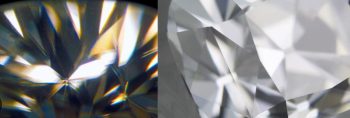
Price
Aquamarine and blue topaz are both beautiful gemstones that are often used in jewelry. When it comes to cost, there is a noticeable difference between the two. Aquamarine tends to be more expensive than blue topaz. The price of aquamarine is influenced by factors such as its color, clarity, and size. On the other hand, blue topaz is generally more affordable. However, it’s important to note that the cost of both gemstones can vary depending on the quality and market demand.
So, if you find a 3 carat, beautiful ocean blue aquamarine for $25, then you are probably being sold a topaz. Aquamarine can cost as much as 30 times as much as topaz.
Custom Jewelry
One way to ensure you are getting an aquamarine and not a topaz is to use a reputable custom jeweler. We make custom jewelry to order. And that is all we do. That means we source each stone for each piece of jewelry that we make. We also use reputable gemstone dealers. And on top of that, we have a GIA graduate gemologist on hand who can verify every stone’s species. This ensures that if we sell a stone as a certain species, you can trust that it is what we say it is.
Another benefit of custom jewelry is that you get a piece made just for you. Why buy a mass produced piece of jewelry that 1000’s of people can have? We can create something that shows your personality and style. And many times, it can cost less than a comparable piece from a mall jewelry store.
You can view our portfolio of custom engagement rings or custom pendants to look for ideas. Or you can contact us with your own idea.
